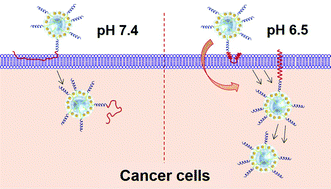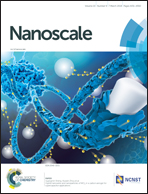An upconversion nanoplatform with extracellular pH-driven tumor-targeting ability for improved photodynamic therapy†
Abstract
Upconversion nanoparticles (UCNPs) are widely utilized for photodynamic therapy (PDT) due to their specific upconverting luminescence that utilizes near infrared (NIR) light to excite photosensitizers (PSs) for PDT. The efficiency of UCNP-based PDT will be improved if the cancer-targeting property of nanomedicine is enhanced. Herein, we employed the pH low insertion peptide (pHLIP), a cancer-targeting moiety, to functionalize an 808 nm excited UCNP-based nanoplatform that has a minimized over-heating effect to perform PDT. pHLIP can bring cargo specifically into cancer cells under an acidic environment, realizing the effective active-targeting abilities to cancer cells or tumor due to acidosis. The pHLIP-functionalized nanoplatform was assembled and well characterized. The nanoplatform shows an efficient NIR-irradiated PDT effect in cancer cells, especially under a slightly acidic condition that mimics the tumor microenvironment, and this effectiveness is attributed to the targeting properties of pHLIP to cancer cells under acidic conditions that favor the entry of the nanoplatform. Furthermore, the pHLIP-functionalized nanoplatform shows a favorable safety profile in mice with a high maximum tolerated dose (MTD), which may broaden the availability of administration in vivo. The efficient in vivo antitumor activity is achieved through intratumor injection of the nanoplatform followed by NIR irradiation on the breast tumor. The nanoparticles are largely accumulated in the tumor site, revealing the excellent tumor-targeting properties of the pHLIP-functionalized nanoplatform, which ensures efficient PDT in vivo. Moreover, the nanoparticles have a long retention time in the bloodstream, indicating their stability in vivo. Overall, we provide an example of a UCNP-based nanosystem with tumor-targeting properties to perform efficient PDT both in vitro and in vivo.



 Please wait while we load your content...
Please wait while we load your content...